

|
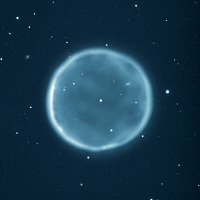 |
Abell 39 Planetary Nebula Spectral Type: () aka: () Located: 00 28 20.0 -11 23 24.0 Data Source:WIYN/NOAO/NSF Credit: NOAO |
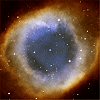 |
NGC 7293 Planetary Nebula Spectral Type: DA (D) aka: Helix Nebula, WD 2226-210 Located (ra & dec):22 29 38.55 -20 50 13.6 Data Source: C.D.S. - SIMBAD4 rel 1.100 - 2008.10.14CEST03:08:22 Credit: Simbad, RGB Image |
|
A planetary nebula is an emission nebula consisting of a glowing shell of gas and plasma formed by certain types of stars when they
die.
- Wikipedia - Planetary Nebula A planetary nebula is created when a star blows off its outer layers after it has run out of fuel to burn. These outer layers of gas expand into space, forming a nebula which is often the shape of a ring or bubble. About 200 years ago, William Herschel called these spherical clouds planetary nebulae because they were round like the planets. At the center of a planetary nebula the glowing, left-over central part of the star from which it came can usually still be seen. - Ask an Astronomer, Cool Cosmos at the Infrared Processing and Analysis Center & the SIRTF Science Center The planetary nebula is part of a star's stellar life cycle, it's own contribution to the cosmic art gallery if you will. Having a mass up to eight to twelve times greater than our own sun and now out of fuel to burn the star ejects it's outer layers, shedding them to the stellar winds it creates, leaving behind a brillantly glowing central core called a white dwarf. A shell or 'bubble' of plasma & gases form out of the star's shedded material which is then ionized by it's own ultraviolet radition, causing the shell to glow. - K.Pinkela |
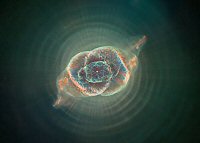 |
NGC6543 Planetary Nebula Spectral Type: The results of field survey data & two (disparte) spectral analysis indicate a structurally complex nebula that has produced more than a few mysteries [Ref. 1] [Ref. 2] aka: Cat's Eye Nebula, Snail Nebula, HD 164963 Located (ra & dec): 17 8 33.423 +66 37 59.52 Data Source: C.D.S. - SIMBAD4 rel 1.100 - 2008.10.14CEST06:46:54 Credit: APOD |
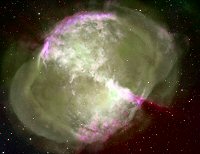 |
NGC6853 Planetary Nebula Spectral Type: DA (D) aka: M 27, Dumbbell Nebula, WD 1957+225 Located (ra & dec): 19 59 36.340 +22 43 16.09 Data Source: C.D.S. - SIMBAD4 rel 1.100 - 2008.10.14CEST07:06:51 Credit: Michael Pierce, Robert Berrington (Indiana University) Nigel Sharp, Mark Hanna (NOAO)/WIYN/NSF |
|
NEBULA PAGE GOAL: "To Share an awe inspiring beauty who's life is only seconds long when measured against the universe's scale of time." Ten to fifteen-thousand years or so old may sound like a mighty long time to live however, when compared with the age of a star, millions to billions of years old, your still just an infant. Taking a mid-range example of a star's age, say 6 billion years, a single nebula could live out 600,000 life times or more. But short-lived or not the Nebula is still able to enjoy a fairly active stellar existence while it's benefactor, the red giant star, is now fighting for it's own. Having consumed most of the hydrogen fuel that feed it's own fusion procecss the star begins to cool down and change: "...stars convert hydrogen to helium to produce light (and other radiation). As time progresses, the heavier helium sinks to the center of the star, with a shell of hydrogen around this helium center core. The hydrogen is depleted so it no longer generates enough energy and pressure to support the outer layers of the star. As the star collapses, the pressure and temperature rise until it is high enough for helium to fuse into carbon, i.e. helium burning begins. To radiate the energy produced by the helium burning, the star expands into a Red Giant." - Jeff Silvis, Ask an Astrophysicist Thereafter, the expanding red giant sheds or casts off with stellar-like winds it outer layers, leaving behind an inert core consisting mostly of carbon and oxygen and known as a white dwarf star. And it is the white dwarf who radiates out and over the dust, gases and plasma of it's own remains. | 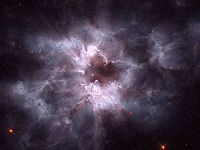 NGC 2440-Planetary Nebula At the center of the nebula is the very hot White Dwarf Star HD 62166 |
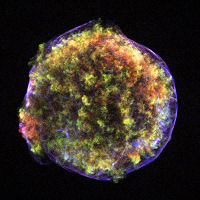 Supernova Remnant SN1572 |